ANDYBROUWER.CO.UK
CAMBODIA
TALES 1998
Freewheeling
in Phnom Penh
 I was up
early at 6am to view the spectacular sunrise over the confluence
of the Mekong and Tonle Sap rivers from a spot directly in front
of the Royal Palace. Turning around, the yellow brick of the Chan
Chaya Pavilion shone brightly, two elephants and their handlers
moved languidly amongst the early morning traffic and a group of
bleary-eyed cyclo drivers used the waters of the Tonle Sap for
their ablutions. Wat Ounalom was my first port of call and
although the main vihara was locked shut, I paused to admire the
skill of three stonemasons at work on a statue in the temple
grounds. Around the corner, Wat Saravoan resembled a construction
site and was in the throes of a complete overhaul so I moved onto
the Foreign Correspondents Club, back along the riverfront, for
some breakfast.
I was up
early at 6am to view the spectacular sunrise over the confluence
of the Mekong and Tonle Sap rivers from a spot directly in front
of the Royal Palace. Turning around, the yellow brick of the Chan
Chaya Pavilion shone brightly, two elephants and their handlers
moved languidly amongst the early morning traffic and a group of
bleary-eyed cyclo drivers used the waters of the Tonle Sap for
their ablutions. Wat Ounalom was my first port of call and
although the main vihara was locked shut, I paused to admire the
skill of three stonemasons at work on a statue in the temple
grounds. Around the corner, Wat Saravoan resembled a construction
site and was in the throes of a complete overhaul so I moved onto
the Foreign Correspondents Club, back along the riverfront, for
some breakfast.
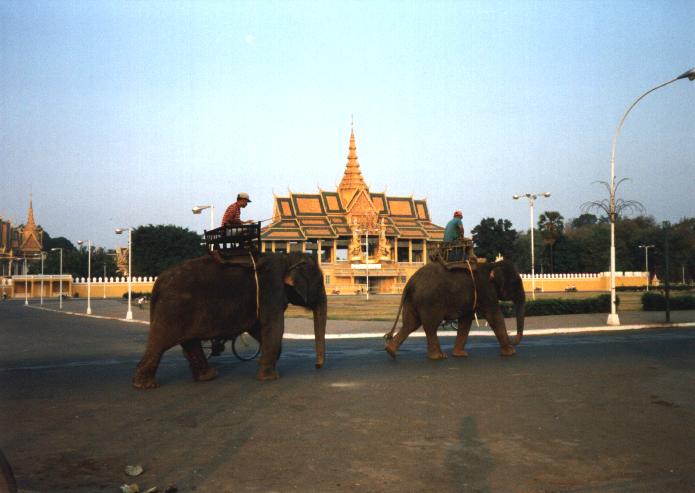 At 8am, I was
the first customer of the day at the National Museum, located to
one side of the Royal Palace compound, with the sun enhancing its
rust-coloured, traditionally styled exterior (below). Entry cost
$2 and I walked through the massive double doors of the entrance,
past the front desk with its reproductions and postcards and
handed over my camera as photography was prohibited inside. The
museum is built around an interior courtyard and four ornamental
lotus ponds with four surrounding ground-floor galleries
containing well in excess of 5,000 bronze, stone, ceramic and
wooden exhibits. I was aware that sixty-six of the museum's best
pieces weren't on show. Alongwith another fifty items from the
renowned Musee Guimet in Paris, they were taking the cream of
Khmer art and sculpture to the masses on an exhibition tour of
France, the USA and Japan. Amongst the most famous sculptures
missing were the Harihara from Prasat Andet, a carved pediment
and a Shiva & Uma couplet from Banteay Srei, a reclining
bronze Vishnu found at the West Mebon and perhaps the most
famous, an exquisitely sculptured head of Jayavarman VII from
Preah Khan. All of these had been on view on my previous visits
to the museum, but at least it gave the chance for other pieces
to share the limelight for a change.
At 8am, I was
the first customer of the day at the National Museum, located to
one side of the Royal Palace compound, with the sun enhancing its
rust-coloured, traditionally styled exterior (below). Entry cost
$2 and I walked through the massive double doors of the entrance,
past the front desk with its reproductions and postcards and
handed over my camera as photography was prohibited inside. The
museum is built around an interior courtyard and four ornamental
lotus ponds with four surrounding ground-floor galleries
containing well in excess of 5,000 bronze, stone, ceramic and
wooden exhibits. I was aware that sixty-six of the museum's best
pieces weren't on show. Alongwith another fifty items from the
renowned Musee Guimet in Paris, they were taking the cream of
Khmer art and sculpture to the masses on an exhibition tour of
France, the USA and Japan. Amongst the most famous sculptures
missing were the Harihara from Prasat Andet, a carved pediment
and a Shiva & Uma couplet from Banteay Srei, a reclining
bronze Vishnu found at the West Mebon and perhaps the most
famous, an exquisitely sculptured head of Jayavarman VII from
Preah Khan. All of these had been on view on my previous visits
to the museum, but at least it gave the chance for other pieces
to share the limelight for a change.
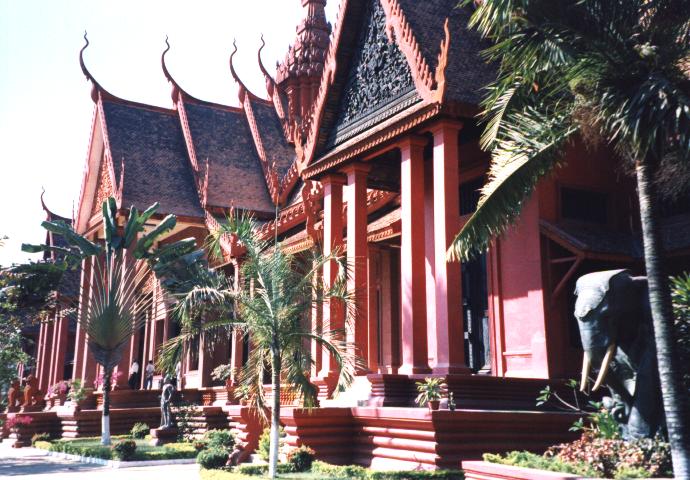 The first
gallery housed a series of smaller objects, mostly bronzes, in
glass display cases, with the remaining galleries containing
larger sandstone exhibits in chronological order from the sixth
to the 13th century. Also on display were pottery pieces, a royal
barge and palanquin, dance costumes and exhibits illustrating
both military and court life. Despite the lack of important
pieces, there was still a wealth of quality carvings including
two Jayavarman VII heads, large free-standing Vishnu sculptures
and a collection of lintels, pediments and frontons. Much in
evidence on the floor and on some of the exhibits was the calling
card of the museum's other inhabitants, droppings from thousands
of freetail bats that live in the roof space. Despite an
artificial ceiling installed with aid from the Australian
government, the corrosive guano and high-pitched squeal of the
bats at rest were a constant companion throughout my visit. In
the quieter inner courtyard, the original Leper King statue,
removed from the terrace of the same name at Angkor Thom for
safekeeping, stands in splendid isolation.
The first
gallery housed a series of smaller objects, mostly bronzes, in
glass display cases, with the remaining galleries containing
larger sandstone exhibits in chronological order from the sixth
to the 13th century. Also on display were pottery pieces, a royal
barge and palanquin, dance costumes and exhibits illustrating
both military and court life. Despite the lack of important
pieces, there was still a wealth of quality carvings including
two Jayavarman VII heads, large free-standing Vishnu sculptures
and a collection of lintels, pediments and frontons. Much in
evidence on the floor and on some of the exhibits was the calling
card of the museum's other inhabitants, droppings from thousands
of freetail bats that live in the roof space. Despite an
artificial ceiling installed with aid from the Australian
government, the corrosive guano and high-pitched squeal of the
bats at rest were a constant companion throughout my visit. In
the quieter inner courtyard, the original Leper King statue,
removed from the terrace of the same name at Angkor Thom for
safekeeping, stands in splendid isolation.
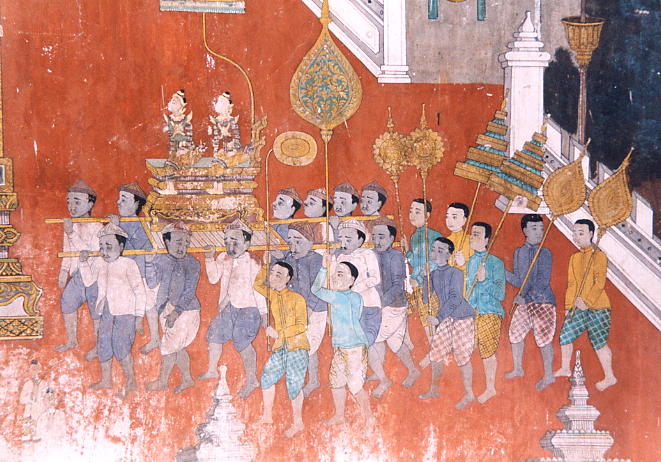 Schoolboys
were playing football, bare-foot, in the park in front of the
museum, as I walked along Samdech Sothearos Boulevard, past the
imposing Chan Chaya Pavilion, still bathed in glorious sunlight
and up to the entrance of the Silver Pagoda. Situated directly
opposite the entrance of my own hotel, the Renakse, the Silver
Pagoda is the only accessible area of the Royal Palace complex
for most of the year. On special occasions, the Throne Hall,
Royal Treasury, Banquet Hall and French Pavilion are opened up to
the public and I was privileged to visit these sumptuous royal
residences on my last trip twelve months earlier. However, on
this occasion, they were off-limits. Entry into the Silver Pagoda
compound, with my camera, cost $5. Along the inside of the
600-metre external wall is a colourful mural (left) depicting
scenes from the Reamker, the Khmer version of the Ramayana, which
has recently been partially restored to its former glories. The
rest of the compound is a collection of royal stupas, pavilions
and the jewel in the crown, the Silver Pagoda, also known as Wat
Preah Keo Morokat.
Schoolboys
were playing football, bare-foot, in the park in front of the
museum, as I walked along Samdech Sothearos Boulevard, past the
imposing Chan Chaya Pavilion, still bathed in glorious sunlight
and up to the entrance of the Silver Pagoda. Situated directly
opposite the entrance of my own hotel, the Renakse, the Silver
Pagoda is the only accessible area of the Royal Palace complex
for most of the year. On special occasions, the Throne Hall,
Royal Treasury, Banquet Hall and French Pavilion are opened up to
the public and I was privileged to visit these sumptuous royal
residences on my last trip twelve months earlier. However, on
this occasion, they were off-limits. Entry into the Silver Pagoda
compound, with my camera, cost $5. Along the inside of the
600-metre external wall is a colourful mural (left) depicting
scenes from the Reamker, the Khmer version of the Ramayana, which
has recently been partially restored to its former glories. The
rest of the compound is a collection of royal stupas, pavilions
and the jewel in the crown, the Silver Pagoda, also known as Wat
Preah Keo Morokat.
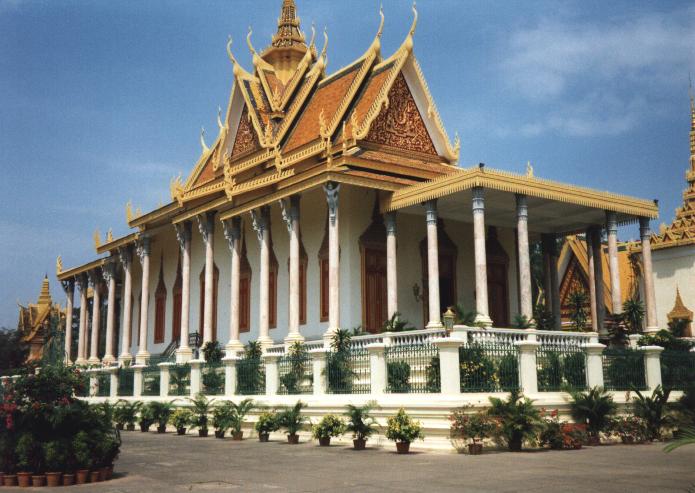 Wat Preah Keo
Morokat (right) houses an accumulation of thousands of gold,
silver and marble Buddha statues of varying shapes and sizes. Two
in particular are priceless. The 17th century Emerald Buddha is
made of baccarat crystal and sits atop a high pedestal and
another, weighing 90kg, made of pure gold and encrusted with
9,584 diamonds, is nearby. The floor of the Silver Pagoda is
covered with 5,329 solid silver tiles, hence its name.
Photography and shoes were not allowed inside and electric fans
offered some relief from the intense humidity as I viewed the
contents of the glass display cabinets, containing gifts to the
Khmer monarchy from foreign dignitaries. Outside, stupas
containing the ashes of former kings, a library and two pavilions
housing large footprints of the Buddha lead onto an annexe. As
well as a souvenir shop, the Palace workshops and an Elephant
Pavilion displaying coronation items, a small group of young
female dancers and musicians from the School of Fine Arts
performed a truncated version of a classical Khmer dance, full of
graceful movement and sequined costumes.
Wat Preah Keo
Morokat (right) houses an accumulation of thousands of gold,
silver and marble Buddha statues of varying shapes and sizes. Two
in particular are priceless. The 17th century Emerald Buddha is
made of baccarat crystal and sits atop a high pedestal and
another, weighing 90kg, made of pure gold and encrusted with
9,584 diamonds, is nearby. The floor of the Silver Pagoda is
covered with 5,329 solid silver tiles, hence its name.
Photography and shoes were not allowed inside and electric fans
offered some relief from the intense humidity as I viewed the
contents of the glass display cabinets, containing gifts to the
Khmer monarchy from foreign dignitaries. Outside, stupas
containing the ashes of former kings, a library and two pavilions
housing large footprints of the Buddha lead onto an annexe. As
well as a souvenir shop, the Palace workshops and an Elephant
Pavilion displaying coronation items, a small group of young
female dancers and musicians from the School of Fine Arts
performed a truncated version of a classical Khmer dance, full of
graceful movement and sequined costumes.
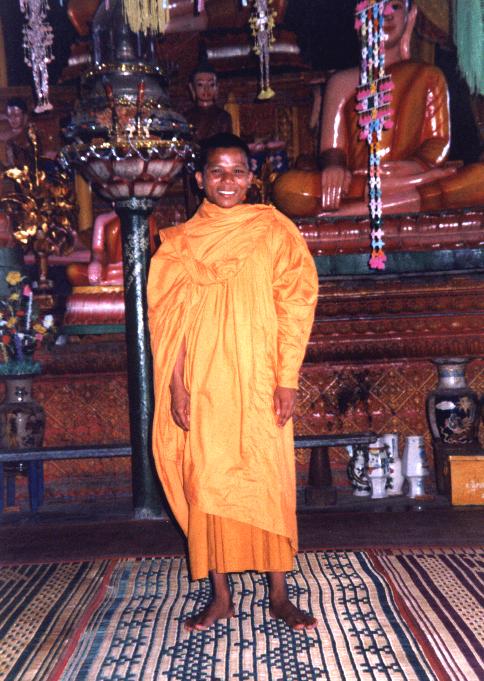 I briefly returned to my hotel room across
the street for a cold shower, where one of the all-too-frequent
powercuts was taking place and then lunched at the FCC, looking
out across the Tonle Sap river and the Chrouy Changva Peninsular
in the distance. At 2pm, Onphum, my regular motodub, collected me
from the hotel, a two-minute walk from the FCC, and we set off
for a whistle-stop tour of some of the capital's major wats and a
visit to the office of the Documentation Centre of Cambodia
(DC-Cam), an academic research institute. Wat Botum is a large
pagoda complex, with many ornate stupas and structures, located
next to the park housing the Vietnam-Cambodia Friendship
Monument. It's a favoured wat of royalty, although the main
vihara was closed when we stopped by. In close proximity to the
Independence Monument, Wat Langka is one of the capital's five
original monasteries founded in 1422. The main temple contained
colourful paintings of the Buddha's life on two floors and was a
hive of activity with monks, novices and laypeople going about
their daily business. Onphum suggested a visit to Wat Moha
Montrei, near the Olympic Stadium before our 3pm appointment at
the DC-Cam Centre. A friendly monk (left) explained as best he
could in broken English, the meaning of the large life-of-Buddha
paintings although the vihara was very dark and the paintings
were well above eye level. I had to decline his offer of tea in
the monks' quarters to return to Sihanouk Boulevard in time for
my scheduled appointment at the DC-Cam Centre.
I briefly returned to my hotel room across
the street for a cold shower, where one of the all-too-frequent
powercuts was taking place and then lunched at the FCC, looking
out across the Tonle Sap river and the Chrouy Changva Peninsular
in the distance. At 2pm, Onphum, my regular motodub, collected me
from the hotel, a two-minute walk from the FCC, and we set off
for a whistle-stop tour of some of the capital's major wats and a
visit to the office of the Documentation Centre of Cambodia
(DC-Cam), an academic research institute. Wat Botum is a large
pagoda complex, with many ornate stupas and structures, located
next to the park housing the Vietnam-Cambodia Friendship
Monument. It's a favoured wat of royalty, although the main
vihara was closed when we stopped by. In close proximity to the
Independence Monument, Wat Langka is one of the capital's five
original monasteries founded in 1422. The main temple contained
colourful paintings of the Buddha's life on two floors and was a
hive of activity with monks, novices and laypeople going about
their daily business. Onphum suggested a visit to Wat Moha
Montrei, near the Olympic Stadium before our 3pm appointment at
the DC-Cam Centre. A friendly monk (left) explained as best he
could in broken English, the meaning of the large life-of-Buddha
paintings although the vihara was very dark and the paintings
were well above eye level. I had to decline his offer of tea in
the monks' quarters to return to Sihanouk Boulevard in time for
my scheduled appointment at the DC-Cam Centre.
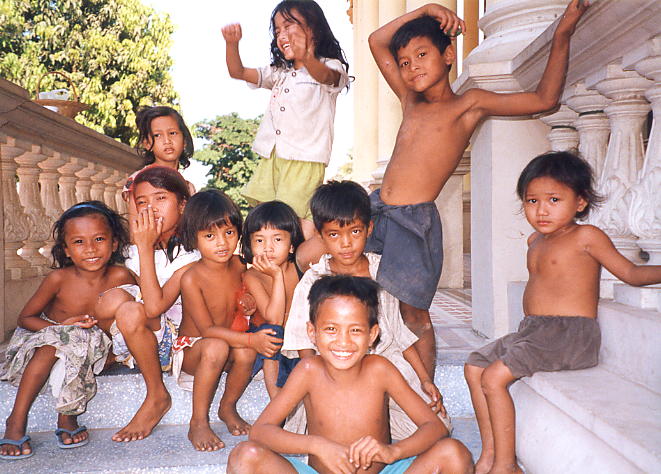 Located in a nondescript house, the DC-Cam
was originally a field office for Yale University's Cambodian
Genocide Program, looking into the Khmer Rouge period of 1975-79.
Run by Cambodians, the well-organised DC-Cam office has a wealth
of information, both computerised and in paper form, on the
activities of the Khmer Rouge regime, including details of all
known prisons, mass grave sites and memorials criss-crossing the
country. After a chat with its director, Youk Chhang, I rejoined
Onphum for our final wat stop of the afternoon, at Wat Than on
Norodom Boulevard. Renowned for its workshops and skills training
program for landmine and polio handicapped, a shop selling the
fruits of their labours is on site. I toured the production
workshops, where eager students are taught carpentry, tailoring
and weaving and visited the typing centre before returning to the
showroom to purchase some gifts for my family back home. Outside
the main vihara, a group of youngsters welcomed me into their
flip-flop throwing game, called 'kop sbek cheung' in Khmer, and I
thanked them with a handful of balloons before leaving to make
our way back to the hotel for a deserved rest as dusk settled on
another eventful day.
Located in a nondescript house, the DC-Cam
was originally a field office for Yale University's Cambodian
Genocide Program, looking into the Khmer Rouge period of 1975-79.
Run by Cambodians, the well-organised DC-Cam office has a wealth
of information, both computerised and in paper form, on the
activities of the Khmer Rouge regime, including details of all
known prisons, mass grave sites and memorials criss-crossing the
country. After a chat with its director, Youk Chhang, I rejoined
Onphum for our final wat stop of the afternoon, at Wat Than on
Norodom Boulevard. Renowned for its workshops and skills training
program for landmine and polio handicapped, a shop selling the
fruits of their labours is on site. I toured the production
workshops, where eager students are taught carpentry, tailoring
and weaving and visited the typing centre before returning to the
showroom to purchase some gifts for my family back home. Outside
the main vihara, a group of youngsters welcomed me into their
flip-flop throwing game, called 'kop sbek cheung' in Khmer, and I
thanked them with a handful of balloons before leaving to make
our way back to the hotel for a deserved rest as dusk settled on
another eventful day.
Cambodia Tales : Messageboard : Next : E-mail
The contents of this website cannot be
reproduced or copied without permission of the site author. © Andy Brouwer 2006
 I was up
early at 6am to view the spectacular sunrise over the confluence
of the Mekong and Tonle Sap rivers from a spot directly in front
of the Royal Palace. Turning around, the yellow brick of the Chan
Chaya Pavilion shone brightly, two elephants and their handlers
moved languidly amongst the early morning traffic and a group of
bleary-eyed cyclo drivers used the waters of the Tonle Sap for
their ablutions. Wat Ounalom was my first port of call and
although the main vihara was locked shut, I paused to admire the
skill of three stonemasons at work on a statue in the temple
grounds. Around the corner, Wat Saravoan resembled a construction
site and was in the throes of a complete overhaul so I moved onto
the Foreign Correspondents Club, back along the riverfront, for
some breakfast.
I was up
early at 6am to view the spectacular sunrise over the confluence
of the Mekong and Tonle Sap rivers from a spot directly in front
of the Royal Palace. Turning around, the yellow brick of the Chan
Chaya Pavilion shone brightly, two elephants and their handlers
moved languidly amongst the early morning traffic and a group of
bleary-eyed cyclo drivers used the waters of the Tonle Sap for
their ablutions. Wat Ounalom was my first port of call and
although the main vihara was locked shut, I paused to admire the
skill of three stonemasons at work on a statue in the temple
grounds. Around the corner, Wat Saravoan resembled a construction
site and was in the throes of a complete overhaul so I moved onto
the Foreign Correspondents Club, back along the riverfront, for
some breakfast.




